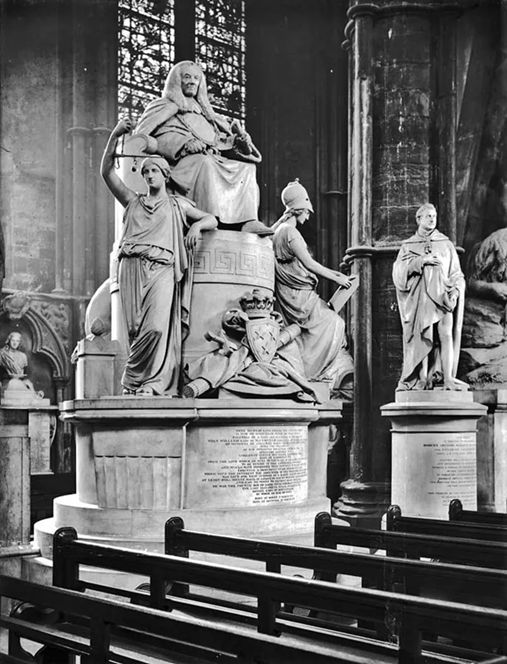This important drawing shows John Flaxman’s most ambitious early monument, commissioned to commemorate the Lord Chief Justice, William, 1st Earl of Mansfield in Westminster Abbey. Commissioned by Mansfield’s nephew and heir, Viscount Stormont, the project was begun in 1793 the year his uncle died. Mansfield had wanted a private burial, but a bequest from a suitor who had benefited from one of Mansfield’s judgments meant that there was a considerable fund to enable Flaxman to produce an ambitious multi-figural group. The monument was completed in 1801 and the present drawing may well be Flaxman’s record of the group in situ in the West corner of the north transept of the abbey. The siting of the sculpture was of huge importance to Flaxman, who petitioned the Dean to change panes of glass from the neighbouring window changed to grey glass to reduce glare. The monument was moved in 1933 destroying the original context. This drawing carefully worked in pencil and ink wash points to Flaxman’s concern with sight lines and how the sculpture would work within its architectural context.
Flaxman was still in Italy when he was chosen to design Mansfield’s tomb and Sir William Hamilton was asked to approve the design. From the first, Flaxman seems to have conceived the broad details of the design that was to be finally executed. Mansfield was shown in his robes as a judge seated above the personifications of Justice and Wisdom, wearing Minerva’s helmet. Conscious that the monument would be free standing, Flaxman placed the figure of a young man seated at the back of the group, this was identified by David Irwin as a wingless Genius of Death, formally linking Flaxman’s design with Antonio Canova’s monument to Clement XIII in St Peter’s which had been newly installed in 1792. Flaxman was back in Britain by 1797, when he was made an associate of the Royal Academy and was able to inspect the location of his monument. The present drawing may show Flaxman projecting the appearance of his monument in its proposed position in Westminster Abbey, or show the monument after its installation. The finished drawing is carefully inscribed and signed ‘J. Flaxman RA’, Flaxman was elected a full academician in 1800 giving a terminus post quem. Three further drawings survive in the collection of University College, London, each showing the tomb from a different angle, also including the architectural setting.[1]
This drawing is first recorded in the collection of the solicitor and antiquarian Edward Basil Jupp. Jupp acquired a number of Flaxman’s drawings at the Flaxman sale, Christie’s 10 April, 1862, including a pair of drawings now at the British Museum.[2] Jupp used the drawings to extra illustrate a set of Royal Academy catalogues which were broken up in 1913. A number of drawings from Jupp’s collection, including an important early drawing by William Blake is now in the British Museum. The present sheet was part of an extra illustrated volume acquired by Thomas William Waller.



